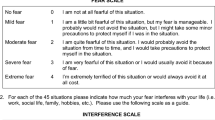Abstract
The Dating Anxiety Survey (DAS) was constructed to assess dating anxiety in males and females. Factor analysis of the survey revealed three factors: passive contact, active intentions for dating, and dating interactions. The reliabilities of the three subscales, as determined by coefficient alpha, were .87, .91, and .93 for males and .90, .90, and .92 for females, respectively. Correlations with dating history and a measure of social anxiety were generally of a low but significant magnitude, providing some support for concurrent validity. The results of the factor analysis lend support to the construct validity of the DAS. These findings suggest that the DAS is a potentially useful instrument in the self-report of dating anxiety.
Similar content being viewed by others
References
Borkovec, T. D., Stone, N. M., O'Brien, G. T., & Kaloupek, D. G. (1974). Evaluation of a clinically relevant target behavior for analog outcome research.Behavior Therapy, 5, 503–513.
Calvert, J. D. (1984).Behavioral assessment of social skills and dating anxiety in female college students. Unpublished master's thesis. Baton Rouge: Louisiana State University.
Carver, C. S., & Glass, D. C. (1976). The self-consciousness scale: A discriminant validity study.Journal of Personality Assessment, 40, 169–172.
Carver, C. S., & Scheier, M. F. (1978). Self-focusing effects of dispositional self-consciousness, morror presence, and auditory presence.Journal of Personality and Social Psychology, 36, 324–332.
Carver, C. S., & Scheier, M. F. (1981).Attention and self-regulation: A control-theory approach to human behavior. New York: Springer-Verlag.
Comrey, A. L. (1973).A first course in factor analysis. New York: Academic.
Curran, J. P., & Gilbert, F. S. (1975). A test of the relative effectiveness of a systematic desensitization program and an interpersonal skills training program with date anxious subjects.Behavior Therapy, 6, 510–521.
Curran, J. P., Wallander, J. L., & Farrell, A. D. (1985). Heterosocial skills training. In L. L'Abate & M. A. Milan (Eds.),Handbook of social skills training and research (pp. 136–169). New York: Wiley.
Fenigstein, A., Scheier, M. F., & Buss, A. H. (1975). Public and provate self-consciousness: Assessment and theory.Journal of Consulting and Clinical Psychology, 43, 522–527.
Fishman, S., & Nawas, M. (1973). Treatment of polysomatic or global problems by systematic desensitization. In R. Rubin (Ed.),Advances in behavior therapy. New York: Academic.
Galassi, J. P., & Galassi, M. D. (1979). Modification of heterosocial skills deficits. In A. S. Bellack & M. Hersen (Eds.),Research and practice in social skills training (pp. 131–187). New York: Plenum.
Glass, C. R., Gottman, J. M., & Shmurak, S. H. (1976). Response-acquisition and cognitive self-statement modification approaches to dating-skills training.Journal of Counseling Psychology, 23, 520–526.
Jensen, B. J. (1979).Psychometric validation of the Interaction Scale: A self-report questionnaire for the assessment of heterosexual-social anxiety in males. Unpublished doctoral dissertation. Carbondale: Southern Illinois University.
Martinson, W. D., & Zerface, J. P. (1970). Comparison of individual counseling in a social program with nondaters.Journal of Counseling Psychology, 17, 36–40.
Rehm, L. P., & Marsten, A. R. (1968). Reduction of social anxiety through modification of self-reinforcement: An instigation therapy technique.Journal of Consulting and Clinical Psychology, 32, 565–574.
Richardson, F. C., & Tasto, D. L. (1976). Development and factor analysis of a social anxiety inventory.Behavior Therapy, 7, 453–462.
Scheier, M. F. (1980). Effects of public and private self-consciousness on public expression of personal beliefs.Journal of Personality and Social Psychology, 39, 514–521.
Sechrest, L. (1984). Reliability and validity. In A. S. Bellack & M. Hersen (eds.),Research methods in clinical psychology (pp. 24–54). New York: Pergamon.
Shmurak, S. H. (1973).A comparison of types of problems encountered by college students and psychiatric inpatients in social situations. Unpublished manuscript.
Turner, R. G., Scheier, M. F., Carver, C. S., & Ickes, W. (1978). Correlates of self-consciousness.Journal of Personality Assessment, 42, 285–289.
Twentyman, C. T., & McFall, R. M. (1975). Behavioral training of social skills in shy males.Journal of Consulting and Clinical Psychology, 43, 384–395.
Williams, C. L., & Ciminero, A. R. (1978). Development and validation of a heterosocial skills inventory: The Survey of Heterosexual Interactions for Females.Journal of Consulting and Clinical Psychology, 46, 1547–1548.
Author information
Authors and Affiliations
Rights and permissions
About this article
Cite this article
Calvert, J.D., Moore, D. & Jensen, B.J. Psychometric evaluation of the dating anxiety survey: A self-report questionnaire for the assessment of dating anxiety in males and females. J Psychopathol Behav Assess 9, 341–350 (1987). https://doi.org/10.1007/BF00964562
Accepted:
Issue Date:
DOI: https://doi.org/10.1007/BF00964562




